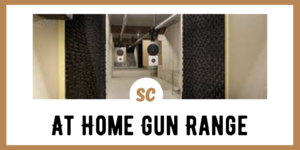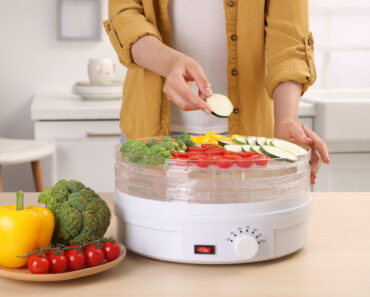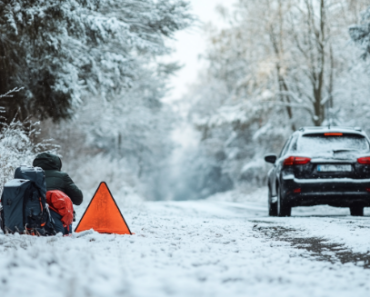Many of us dream about the possibility. Imagine heading out to your private gun range where you can practice your shooting skills any time.
For those fortunate enough to live in rural areas with enough space, this may be a simple matter. However, for urban dwellers, it becomes a bit more complicated. Space, zoning laws, and insurance all factor into having a private home gun range.
A shooting range is typically not something many people consider adding to their homes. An indoor shooting range requires specialized design features that put the project beyond the reach of most homeowners.
The obvious factors are containment to control the flight of bullets and mitigating the noise.
What many people forget is the need for specialized air filtration systems to ensure the air in the home gun range remains safe and to prevent spreading toxic substances like lead into the atmosphere.
Home shooting ranges are wonderfully convenient and allow you to practice shooting in ways that most public and even private membership ranges don’t allow. If you are a reloading enthusiast, being able to test your new loads quickly and easily can be a major attraction.
A home shooting range may enhance the value of your home and will certainly make you popular with your other shooting friends.
Is it Legal to Put a Shooting Range in your Home?
In general, it is legal to put a shooting range in your home. However, every jurisdiction differs in its laws, regulations, and zoning requirements.
If you live in a neighborhood with a homeowners association, you may face additional roadblocks to installing an in-home gun range.
Start At the Beginning
If you intend to have your own shooting range in your home, the first step is determining the requirements of your local ordinances and zoning laws. A good place to start this inquiry is at the local building inspection office that does plan approvals for your area.
Most building inspection departments will be happy to give you all of the requirements needed to pass the code inspection and get your building permit.
You May Be Required to Notify Your Neighbors
Some cities and jurisdictions may consider an in-home gun range a non-conforming use. Before they will issue a building permit, you may need to contact all of your neighbors and notify them of your intent to install a home shooting range.
In some instances, your neighbors may be able to register a formal complaint with the building inspection department that could prevent you from installing a shooting range in your home.
Make Sure Your Home Owners Association Has No Objections
The deed to your home may include a list of prohibited activities or additions to your home. Some homeowners associations can also be quite restrictive in what they will allow you to do in your own home.
Be sure that any covenants, deed restrictions, or homeowner association agreements don’t conflict with your home gun range plans.
Check With Your Home Owners Insurance Agent
Some people forget about the insurance angle when installing a home shooting range. It can create large problems if you build your home gun range and then discover that your insurance company will no longer provide insurance coverage for your home.
Insuring an in-home gun range can be a tricky proposition in some areas. Consult with your insurance agent before you start construction.
You Will Need to Hire Professionals
You will probably need to provide a set of professionally drawn building plans with the specifications for all the construction and equipment that will be used in your indoor shooting range.
This may require hiring a qualified architect or engineer. Licensed architects and engineers in your jurisdiction will be knowledgeable about the building requirements in your area.
Some companies specialize in building home shooting ranges that will work with you to prepare all the legal and construction documents you may need to get your building permits.
Some of these companies may even help you with problems associated with homeowners associations.
Finally, Consider the Cost
Building a shooting range in your home is not an inexpensive project. The equipment to operate a shooting range safely can run into tens of thousands of dollars.
Special air handling equipment, construction costs to ensure the range design is safe, and the additional insurance costs all make an in-home shooting range a costly proposition.
Is It Possible to Put a Usable Gun Range in a Home?
You can certainly manage to install a usable home shooting range in many homes. There are some things you should explore as you consider the addition of a firing range in your home that may alter your plans or prevent you from completing your project.
Home gun ranges require some minimum space requirements that must be met to make them usable.
Where Will You Put a Home Shooting Range?
There are really two options where you will put a home shooting range. You may opt to put your home range above ground in either a free-standing structure or to build it into an existing space in your home. Many homeowners with a basement find that indoor ranges work well in an existing basement.
Installing a home range in an existing above-ground space or into an existing basement can be the less costly option.
Additions to homes can get expensive if you have the room. Going below ground into a basement offers other advantages that can also cut costs.
How Much Space Do I Need for My Own Range?
Space is always a problem for home gun ranges, especially in urban or suburban locations.
Most experts suggest that the ideal installation for shooting ranges be at least 75 yards long and wide enough to accommodate two 4-foot wide shooting lanes. This typically means a space that is 100 yards long and at least 10 feet wide to accommodate construction and safety factors.
In addition to the footprint size of the firing range, most well-designed indoor shooting ranges will have ceilings of at least 12 feet.
The higher ceilings afford space to install proper safety baffling and to create enough airflow through the space to maintain a healthy environment.
Can I Utilize a Smaller Space for an Indoor Range?
While smaller areas are not ideal for an indoor range, it is possible to create a perfectly functional range in a smaller home space. If you realize that a smaller space may eliminate practicing long-range shooting, you may be quite happy with a smaller space.
Using a smaller space may restrict the style of shooting you perform on your range and limit the caliber that you can safely shoot.
In some cases, it may be preferable to build a home shooting range that is designed only for rimfire ammunition. This allows a smaller space to be used for the range. The bullet traps and safety equipment needed are smaller, lighter, and less expensive than those designed for larger calibers.
Will My Current Basement Work as a Shooting Range?
That is a difficult question to answer. If your basement has solid concrete walls that were poured in place when the basement was built, they might meet the code requirements. However, they could be poured cement and not be thick enough or have enough reinforcing material.
Adequate Walls are Required
If your basement walls are made of pre-cast concrete blocks, there is a good chance the spaces in the blocks were not filled with concrete. Unfilled concrete blocks won’s stop stray bullets and typically don’t meet the building code requirements. Local laws generally require concrete block walls to have concrete in the voids and re-bar reinforcement to meet specifications.
Don’t Forget the Ceiling
Your basement ceiling often serves as the floor for the living space above. This may be nothing more than one or two layers of wooden subflooring which is not adequate to stop an errant bullet.
Not only do you need enough height between the floor and the ceiling to install air handling equipment and baffles along the shooting lanes, but you should reinforce the area to ensure the ceilings provide an adequate level of safety for the occupied space above.
My Basement has HVAC. Isn’t That Adequate?
More than likely, no. Your residential HVAC system is not designed to meet the strict air quality standards required in shooting ranges.
In general, the shooting range area must maintain negative air pressure to ensure that dangerous particle materials are trapped and filtered before putting the filtered air outside the shooting range. Most of these systems utilize commercial HEPA filters.
Proper ventilation is critical for your safety and for the safety and health of others who may visit your firing range or live nearby. It is extremely important that the ventilation system meet the codes for required equipment.
Most indoor ranges are configured so that when the lights are turned on in the range, the ventilation system also comes on. This is the best solution to ensure that the ventilation system performs its job all the time.
Can I Shoot Steel Targets on a Home Shooting Range?
If your range is properly designed and installed, you should have no trouble shooting steel targets on your home range. Well-designed home gun ranges should accept most target systems, including steel targets.
There are some requirements when shooting steel targets that must be followed.
Make Sure Your Target Systems are Rated for Your Caliber
Soft steel targets should not be shot with high velocity or larger caliber ammunition. Not only do you risk damaging the targets, but the danger from ricochets or pieces of target material flying back is increased.
Maintain a Safe Firing Line Distance
If you intend to shoot steel, ensure your home range is long enough to keep your firing line well back of the steel targets to prevent injury from ricochets. Most steel target manufacturers recommend that you be no closer than 25 yards when shooting pistols. Rifles should never be fired on steel targets under 100 yards.
Use the Right Ammunition for your Steel Target Systems
Avoid shooting ammunition that is not intended for steel targets. This includes armor-piercing ammunition, ammunition with steel cores, and ammunition that travels less than 400 feet per second. If you are shooting reactive targets, we suggest that you shoot ball ammo to ensure the target systems work properly.
What Equipment is Required for a Good Home Shooting Range?
Installing a home shooting range needs careful thought and design to make sure that all of the necessary equipment and features are included for safety and security. In general, a well-designed home gun range will include these features and equipment:
A Secure and Safe Place
The structure that houses your indoor shooting range must comply with all federal, state, and local requirements. Most of these laws are designed to protect you and anyone in the area. Your range must include walls and ceilings designed to stop stray bullets or ricochets from leaving the interior of the firing area. In most places, there are stipulations in the codes about noise reduction as well.
Bullet Traps
The heart of any indoor range is the bullet trap. There are many different designs and styles of bullet traps that meet the necessary safety requirements. The style and type of bullet trap depend largely on the size of your range and the types of firearms and calibers of ammo you shoot.
Bullet traps can utilize several methods of capturing the bullets. The simplest is the traditional dirt berm that you often see on outdoor ranges. This can be adapted to indoor ranges, but it can create dust problems.
Some bullet trap systems use a spiral or sloped system to expend the energy or the bullet before it drops into a catchment area. In any case, the bullet trap system must be approved and proven to work effectively.
Ventilation Systems
Your range must have adequate ventilation to ensure that the products of the burning powder, any lead particles, and other toxic substances are removed from the firing area as rapidly as possible.
Many commercial ventilation systems perform these functions. Ventilation can be one of the most expensive parts of building an indoor home gun range.
Target Handling Systems
On any shooting range, you must have some means of holding targets. This can be as simple as a wooden frame onto which paper targets can be stapled or as elaborate as mechanized, computerized systems that can move targets to a specified distance, automatically turn the targets to the shooter, and return the targets to the firing line. In any case, your home shooting range must have some facility to hold targets at the proper position to ensure that bullets enter the bullet trap.
The Firing Line
One important feature of any shooting range is the firing line. The firing line typically has a shelf or table onto which guns and ammunition can be placed.
If an automated target system is employed, the controls for the target system are readily available at the firing line. On some range systems, lighting for the firing line can also be controlled. The firing line is an important safety feature and usually has walls to protect the shooters from ejected brass from neighboring firing stations.
What Other Costs Should be Considered When Building a Home Gun Range?
The cost to build and install a home firing range doesn’t stop when the last nail is driven, and the first bullet is fired. Ongoing maintenance and care are important parts of keeping a home firing range safe and operational over the long haul.
Other costs also become part of the ongoing budget for a home firing range:
Maintenance and Upkeep
Maintenance and upkeep costs are a big part of having a home gun range. Shooting on a firing range is a destructive pastime. The force and energy of the bullets fired downrange inflict damage and wear on the bullet traps, target systems, and the structure of the firing range. To maintain safety, it is important that ongoing maintenance be performed to ensure that these systems operate as designed.
One integral part of a safe home gun range is the ventilation system. To operate efficiently and effectively, the ventilation system must be regularly maintained, especially the filtration portions of the system. Filter elements must be changed or cleaned, and the operating parts of the system must be checked regularly.
Insurance Costs
Before you ever start to build a home range, you should consult with your insurance agent to understand how a home gun range may affect your homeowners and liability insurance coverage. Under most circumstances, there will be an increase in insurance costs once your firing range is operational.
Operating Costs
Don’t be surprised if you find that your budget for ammunition and other shooting supplies suddenly increases. With a firing range in your home, you will more than likely spend much more time with your shooting buddies. This means more ammunition, more targets, and, if things hold true, more entertainment costs.
Your Home Gun Range – A Definite Possibility
Building a home firing range is definitely within the realm of possibilities. If you are an avid shooter and reloader, this may be one of your bucket list items.
Be sure you investigate your local laws before starting construction. We recommend that you hire one of the many manufacturing companies that specialize in home gun range equipment and design to guide you during the process. In the end, you may find it well worth the expense and trouble.


















![Surviving In Your Vehicle [PODCAST]](https://survivalcove.com/wp-content/themes/mts_sociallyviral/images/nothumb-sociallyviral-featured.png)
























